


Middlesex Canal Association P.O. Box 333 Billerica, Massachusetts 01821
www.middlesexcanal.org
| Volume 49 No. 1 | September 2010 |
MCA ACTIVITIES
Please mark your calendars. The 8th Annual Middlesex Canal Bike Ride will be held on Saturday, October 2nd, meeting at Sullivan Square at 9:00am. Our Fall Walk, conducted jointly with the Appalachian Mountain Club (AMC), will be held on Sunday, October 17th, departing from the Wilmington Town Park soon after 1:30pm. And our Fall Meeting will be held at the museum on Sunday, November 7th, beginning at 2:00pm.
See the Calendar, following, for more information on each of these activities. Also included in the calendar are meetings and tours, sponsored by other organizations, in which you may want to participate. Please also check our web site periodically, at the URL noted above, which often lists canal-related events and topics of potential interest.
PRESIDENTíS MESSAGE
by Bill Gerber, President
978-251-4971;
wegerber at gmail dot com
We have an urgent need to recruit volunteers to staff the museum for one or more of the two four-hour periods that the museum is open on each weekend. Can you help? If so, please contact Betty Bigwood (Phone: 978-657-7870 or gbchwilm@comcast.com). She will initially match you up with another volunteer with good knowledge of the canal and its role in the growth and development of Boston and the towns along its route.
An equally serious need is to raise money to pay the rent to sustain our museum. All suggestions and assistance will be gratefully accepted.
Regarding progress toward restoring parts of the canal corridor to public use, Tom Raphael, Chairman of the Middlesex Canal Commission, reports: "We can't say too much about the Mill Pond/Canal Park Project until we get the timetable for the 100% design, and the funding from Northern Middlesex Council on Government (NMCOG) and the Mass Department of Highways. If any projects ahead of us are delayed, perhaps our project can slip in sooner rather than later."
In this issue of Towpath Topics, Howard Winkler winds up his five part series of transcriptions from John Langdon Sullivan's "Letters first published …". Beginning in this issue you will find the first of several transcribed extracts from James Fowle Baldwin's unpublished, 1830 Minutes of the History of the Middlesex Canal, concerning his father's (Colonel Loammi Baldwin's) 1794 trip to view southern canals and meet with Mr. Robert Morris, General Knox and Mr. William Weston.
To update you on Nolan Jones, our longest serving MCA President, he and his wife, Joan, have moved to an assisted living home in Sacramento, CA, to be near Nolan's daughter. Recently from Joan: "Nolan had another 'event' [stroke or TIA] in June, again resulting in more weakness on his left side. After 4 days in UC/Davis Hospital he returned to Pioneer House, but to the Skilled Nursing Facility on the 6th floor. He's been there since, with OT and PT five days a week. Many decisions to be made, e.g., can he be moved to Assisted Living. Nolan is working as hard as ever to regain mobility and balance, but after each event it is more difficult. I can't tell you how much I admire his courage and sweet spirit."
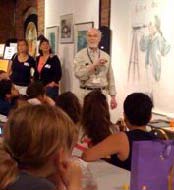 In early June, Betty Bigwood, Jean Potter, and a crew of many organized a birthday party for MCA Director Dave Dettinger. Traci and J. provided transportation services to enable everyone to come. We celebrated with wine, song and a special DVD produced by Roger Hagopian. See Betty's account further on in this issue.
In early June, Betty Bigwood, Jean Potter, and a crew of many organized a birthday party for MCA Director Dave Dettinger. Traci and J. provided transportation services to enable everyone to come. We celebrated with wine, song and a special DVD produced by Roger Hagopian. See Betty's account further on in this issue.
Third grade teacher and MCA Director Traci Jansen once again brought seven classes of students and parents from Wilmington's Woburn Street School to the museum, and to that stretch of canal in Wilmington which includes the Maple Meadow Brook Aqueduct. At the museum, they were greeted by Tom Dahill who entertained them with his artistic prowess - the children love him! We were very pleased that parent Bob Troy once again brought his surveying equipment to provide the children with a hands on experience. Wilmington Selectman Mike Champoux accompanied his son - we enjoyed showing him our Museum. (Is there some way to bottle third graders' energy? There are times when I sure could use a sip! Ed.)
Traci also organized a day-long auto tour of the Middlesex Canal, in which a number of Board members participated. Roger Hagopian planned the route and guided us along, so we all got to see, first hand, many of the areas that Leon Cutler photographed in the 1930s, and which Bert VerPlanck wrote about in his guide book. We started with the northern end of the Canal that Bisected Boston, then moved over to the Charlestown Mill Pond and points north. Most importantly, considering her work with the schools, I think this was helpful to Traci to understand where the canal actually went, in the context of today's topography.
Neil Devins has been putting in a good bit of time in clearing and marking the route of the canal through the Wilmington Town Park. He's also kept the local kiosk supplied with canal guides, which he authored.
In addition to being a very frequent weekend docent, J. J. Breen has been doing a good bit of the maintenance work around the museum, and has been working with Tom Raphael on the placement of highway signage advertising our museum. J. is also gearing up to establish an MCA presence in the forthcoming Yankee Doodle Days parade in Billerica.
And that's about it for this issue.
Bill Gerber
TABLE OF CONTENTS
President's Message (Bill Gerber)
Calendar of Events
Honoring Dettinger on his 91st (Betty Bigwood)
Letters First Published ... #5, by J.L. Sullivan (Howard Winkler)
Instructions to the Colonel - by J. F. Baldwin (Bill Gerber)
America's First Canal? Various Possible Answers (Alan Seaburg)
Endowment Fund (Betty Bigwood)
A NPS Trip through [the] Pawtucket Canal (Neil Devins)
World Canal Conference, Serbia, Sept 2009 (Connie & Tom Raphael)
Miscellany
CALENDAR OF EVENTS
Middlesex Canal Association (MCA) and related organizations
First Wednesday - MCA Board of Directors' Meetings - The Board meets at the Museum, from 3:30pm to 5:30pm, the first Wednesday of each month, except July and August. Members are always welcome to attend.
September 19-24, 2010: World Canals Conference, Rochester, NY. Contact: www.worldcanalsconference.org. Post conference tours Fri, Sept 24, check www.wccrochester.org.
October 1-16, 2010: Study tour of south German waterways. Contact Tom Grasso, www.canalsnys.org.
Sat, October 2, 2010: 8th Annual Historic Middlesex Canal Bicycle Ride. We will meet at Sullivan Square Station at 9:00am, following the route of the Canal 38 miles to Lowell, and taking the train back to Boston. Riders who leave the ride early can take the train back from Wilmington or North Billerica. For further information, contact Dick Bauer (dick.bauer at alum dot mit dot edu).
October 8-10, 2010: Pennsylvania Canal Society tour of the Eastern Division of the Main Line Canal & the few remains of the Conestoga Navigation. For information, please contact Bill Lampert (indnbll at yahoo dot com).
October 15-17, 2010: Canal Society of Ohio tour of the Ohio & Erie Canal in the Cuyahoga Valley National Park, including the canal town of Peninsula. Tour leader: Skip Brausch (440-965-4386; canawler at centurytel dot net).
Sun, October 17, 2010: Joint AMC-MCA Fall Middlesex Canal Walk. 3 mile leisurely walk along scenic section of historic canal to Patch's Pond. Meet at 1:30pm at the Wilmington Town Park parking lot, off Rte. 38. See oxbow, grooves in rocks from towlines, and stone aqueduct. From Rte. 95/128 exit 35 in Woburn, take Rte. 38 north 2.4 miles to Wilmington Town Park lot on left. Info: www.middlesexcanal.org or Roger Hagopian (781-861-7868 to 10pm). Leader: Robert Winters (617-661-9230; robert@middlesexcanal.org).
October 22-24 - "Riverboats, Pirates and Caves." Headquartered in Evansville, IN. Bus tour of southeastern Illinois, Cave In Rock, Garden of the Gods, Ohio River locks, Paducah, Kentucky flood wall murals (possibly Quilters Hall of Fame and the Civil War Museum) on Saturday. Friday tour of LST Ship Memorial in Evansville, Sunday Wabash & Erie Canal, Warrick County, Indiana. Carolyn Schmidt: 260-432-0279, indcanal at aol dot com.
Sunday, November 7, 2010 - MCA Fall Meeting: Tom Raphael, President of the Middlesex Canal Commission and MCA Board member, will discuss "The Middlesex Turnpike - Partner or Competitor to the Canal?" The meeting will be held, beginning at 2:00pm, in the Middlesex Canal Museum and Visitor Center in the Faulkner Mill in North Billerica.
Many of us learned about the 1785 wooden plank road through the Cumberland Pass in Virginia. But few of us were taught that there followed a flurry of turnpike building in all the 13 colonies, all built by private business. All told, 118 turnpikes were completed in Massachusetts, many of which are still with us. Tom's talk will cover the Middlesex Turnpike's construction, problems and uses, and lead us on a virtual journey over the complete route as it was when built, and how it serves us today.
The meeting will be held in the Middlesex Canal Museum and Visitor Center in the Faulkner Mill in North Billerica, beginning at 2:30pm.
Directions to the Museum/Visitors Center: Telephone: 978-670-2740.
By Car: From Rt. 128/95, take Route 3 toward Nashua, to Exit 28 "Treble Cove Road, North Billerica, Carlisle". At the end of the ramp, turn left onto Treble Cove Road toward North Billerica. At about ¾ mile, bear left at a fork. After another ¾ mile, at a traffic light, cross straight over Route 3A. Go about ¼ mile to a 3-way fork; take the middle road, Talbot Street, which will put St. Andrew's Church on your left. Go about ¼ mile and bear right onto Old Elm Street. Go about ¼ mile to the falls, where Old Elm becomes Faulkner Street; the Museum is on your left and you can park across the street on your right, just beyond the falls. From I-495, take exit 37, N. Billerica, south to the road's end at a "T" intersection, turn right, then bear right at the Y, go 700' and turn left into the parking lot. The Museum is across the street.
By Train: The Lowell Commuter Line runs between Boston's North Station and Lowell's Gallagher Terminal. Get off at the North Billerica station, which is one stop south of Lowell. From the station side of the tracks, the Museum is a 3-minute walk down Station and Faulkner Streets on the right side.
Apr 1-3, 2011: "Conquering the Swamp" - The canal societies of Indiana and Ohio will sponsor this tour that covers the Miami & Erie Canal; the Wabash & Erie at Junction, Ohio; and Paulding County, Ohio. Learn the trials of digging through a big swamp.
Apr 29-May 1, 2011: Pennsylvania Canal Society tour of the Lower Division of the Lehigh Navigation.
May 20-22, 2011: The Canal Society of New York State Spring Field Trip: Champlain Canal and the PCB cleanup project at Fort Edward. Headquarters: Queensbury Hotel, Glens Falls, NY. For updates, check the web, www.newyorkcanals.org.
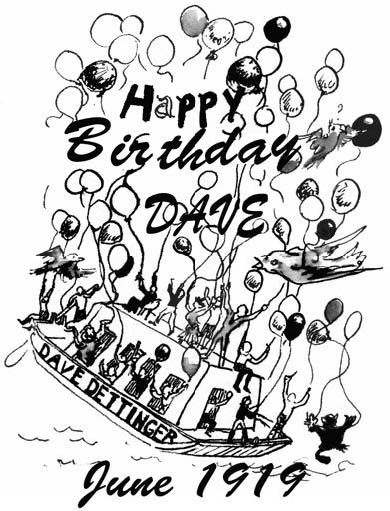 Honoring David Dettinger on his 91st!
Honoring David Dettinger on his 91st!
by Betty Bigwood
What better reason to have a celebration than a 91st Birthday. A long time Middlesex Canal Association Director, Dave has been a prolific contributor; including arranging ten years of key annual events to celebrate the 200th anniversary of the building and opening of the Canal.
On June 5th, more than 50 family members and friends, including his grandsons, Kyle and Ryan, gathered at the Middlesex Canal Museum to salute Dave.
Thomas Dahill designed a happy invitation showing a packet boat, aptly named the David Dettinger, loaded with people carrying balloons – a muskrat even had two balloons. Each was signed by the artist at the top balloon – upside down of course.
The evening began with Paul Wiggin and his banjo - MCA's very own troubadour - leading the group in singing David's song "Haulin Down to Boston on the Middlesex Canal." Dave recently wrote a fifth verse, heard for the first time in public:
We locked into the Charlestown pond,
I thought the job was done
But no – as soon I came to find
the fun had just begun.
We cable-hauled across the Charles:
a new canal was there
which took us straight through Boston town
to reach Haymarket Square
Paul and David had sung for years in a barbershop quartet, though not for the past decade. Two old friends, Ralph Fishman and Bernie Kessell, came to remake the foursome. For thirty minutes they sang oldies – time flew. They were excellent and not a bit rusty! And of course, we joined them to sing Happy Birthday to David.
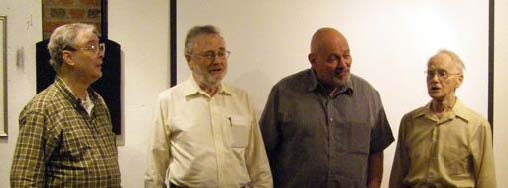
Barbershoppers Paul, Ralph, Bernie and Dave
A buffet of chicken salad, ham biscuits and a variety of tasty salads followed by Birthday cake and ice cream were well received.
Finally, we had a premier viewing of Roger Hagopian's new DVD - of Dave telling his story of "The Canal that Bisected Boston", the result of many years of his research. Roger filmed Dave on site in the North End, pointing out today's topography, as well as at home in a comfortable chair. Roger's attention to detail and knowledge of the subject took this over the top. As David weaved through the Bulfinch Triangle, Canal Street and other landmarks, Roger added maps and pictures of the area. For forty minutes we were well entertained. There are still a few finishing touches to make but I think this is the finest DVD Roger has produced.
LETTERS, First Published in the Boston Daily Advertiser (1818),
in Answer to Certain Inquiries, Relative to the MIDDLESEX CANAL
by John L. Sullivan, Agent of the Corporation. No. V
This is the last of five letters. One, through four were published respectively in the October 2008, April 2009, October 2009, and April 2010 issues of Towpath Topics. The letters have been transcribed by Howard Winkler from an electronic facsimile found at the Tisch Library, Tufts University. Spelling and punctuation have not been changed.
Mr. Hale — The future prospects of the Canal is a topick of more interest than either of those of which I have spoken. And the question whether the proprietors will be remunerated for their expenditure, and rewarded for their patience, and the public be benefitted essentially by their investment and enterprise, is of importance enough to receive a more thorough examination than I am able at this time to give it. The grounds of my own opinion have been in a considerable degree displayed.
We have adverted to the extent and character of the Country to which the Canal leads — have shewn the nature of the business it is calculated to do, and the system on which it has been, and is proposed to be carried on — the amount of it in the tolls through successive years of the commercial and political embarrassments of our Nation, and while the incompleteness and novelty of the accommodation operated unfavourably.
The Proprietary has now attained an eminence to which it has struggled through many difficulties. From which, if those who are interested will look back, they may not on the whole not be dissatisfied. They will perceive a system of business in complete operation between Boston and Concord — that the proprietors have recently adopted a measure recommended by a committee of the board of Directors, which provides for the renovation of the perishable parts of the work. The adequacy of the fund will depend on its being early realized, as well as upon good care of the property—but it is not probable the repairs for five years to come, will exceed half the average of the last ten—say three thousand dollars a year. The fund for repairs is to be formed of the mills and real estate, and all the shares in the auxiliary Canals; this part is already productive—also the two townships of land, and the benefits of the lottery.
The proprietors will naturally distinguish between their immediate and their remote prospects. Everyone will judge for himself, from the state of trade, and the probable demand for materials of building both of ships and houses, whether these sources of income will increase. They may conclude from the articles of transport on the Canal being of the first necessity, that they will always be in demand — lumber & timber, masts, spars & plank must be wanted while we are a commercial and naval people. Wood for fuel, and stone for building are as inexhaustible beyond the Canal, as the want of them on this side is inextinguishable. The transportation into the Country will naturally increase with population and agriculture — and from the Canals being the most direct, central and convenient route for that part of the Country which trades most with Boston, business will divide less and less between us and New-York — suppose any place on the east side the Green mountains to want goods, they can be had from Boston in one third the time and at half the expense of getting them from that City by the way of Connecticut river, unless there happen an uncommonly favourable concurrence of circumstances. The roads now concenter at Concord and at Dunbarton; and the certainty of conveyance is such that these places are becoming depositories like the vicinity of this town.
The corporation has but one considerable debt, which originated in the purchase of an estate in Charlestown, a part of which is designated and reserved as the means of extinguishing it. Thus with this exception, and a few small demands for timber and for professional services, and some old claims for damages on questionable grounds — to no great amount, the proprietary may be considered out of debt.
If business in general should revive, the income of the ensuing year will probably be between thirty and forty thousand dollars. If thirty thousand I see at present no cause to doubt the declaration of a dividend of nineteen to twenty thousand dollars — but let it not be forgotten, by the proprietors that this property is not exempt from casualties.
The productiveness of a property of this kind depends much on the course of measures pursued. If merely opened and left to receive such business as will gradually find its way into it, its increase will be slow. If sources of business are sought and its streams led into it, it will be rapid. This will depend on the views and character of the owners, and the policy they will think proper to adopt — whether the Canal is considered a fixed property that will stand of itself, and that must unavoidably be used; or as a great labour saving machine to be managed, and made more and more productive by active capital. If the former, the proprietors will think they are doing best in having high tolls, if the latter, they will think perhaps that everything ought to come through it on some terms; and a discrimination made in the same article that comes from the greatest distance. Some things should perhaps go free for a limited time until they will bear to pay — hemp, for example will grow very well on the intervals of the Merrimack; might not its culture be induced? Ships got from Boston to the District of Maine to load with lumber and dimension stuff for the British market. Cattle are driven through Concord to the vicinity of Boston at a loss of 10 to 15 per cent; might not beef be as well slaughtered and packed there as in Medford or Charlestown.
In the hands of some men, with a command of capital, this might be made a powerful means of encouraging trade and manufactures through an extensive district abounding in the means of subsistence and productive labour, and by a liberal and vigilant policy greatly extending its own usefulness and revenues.
Tho' this is all practicable, I am sensible there are at present great obstacles.
But are there no inducements to be offered to the National Government to anticipate a little the wants of the navy and turn its attention to the forests of New-Hampshire — much of the same timber that before the revolution was marked for the British navy, stands there in all its native majesty.
There is an essential difference in Canals. — Those which merely connect one manufacturing town with another and with a sea port, are founded on a certain known course of business, as most of those of England. — But the canals of Sweden and of Russia penetrate the country, and their effects and profits are only to be bounded by the limits of improvement. And such the canals of America are to be. They are protected by the nature of the country from parallel and rival enterprises — the sources of their business spring up in the remotest regions, and like the streams that feed our vast rivers, successively unite to swell the current of their usefulness.
We may therefore indulge in reasonable expectations of remote advantages, perhaps not extremely distant, considering the astonishingly rapid progress of our country in every species of improvement. The inland navigation from Boston has not yet one fourth its possible extent. The general Government is greatly interested in it for the navy — this Commonwealth for the effects upon her capital—its inhabitants, and the mercantile interest, for its influence on agriculture, manufactures and the materials of trade and commerce.
The policy which actuates enlightened governments in countries less free, becomes a motive to private associations for public objects amongst a people whose will becomes a law; and as the people have a direct interest in promoting all the means of internal improvement and prosperity, more encouragement and protection may be expected in the United States and elsewhere.
Thus the Southern States are at this moment with unexampled liberality exploring the sources of business. Pennsylvania is ascending the Susquehanna to draw largely on the husbandry of New-York; and that state is actually opening the way to floods of wealth, as incalculable as the limits of the western waters. She will not suffer private associations to possess this mine, for it is justly calculated to yield a vast revenue to the state, when public opinion shall sanction tax on the passage of the Erie Canal, insensible, because instantly remunerated in the price of every commodity. Her Canal will become a fair instrument of her commercial and political aggrandizement, when exportation and importation shall be done at her capital on better terms than elsewhere, and the people of the western states shall find their best interest consulted at this emporium. Connecticut and Vermont have done nothing yet. New-Hampshire has done all she has been requested to do, and is liberally disposed. She assisted in the survey to Connecticut river and has granted a Lottery of 20,000 dollars. Massachusetts has given leave to sell the tickets of that lottery — she paid a large part of the expense of that survey, which will not be lost. She has given a generous act of Incorporation to the proprietors of the Middlesex Canal and two townships of land. We may expect every thing that can be reasonably be asked of Massachusetts, when mature and practically useful plans, are presented for her patronage and participation.
I regret sir, it has not been in my power to give a more deliberate attention to the inquiry on this subject, which occurred at the moment of preparation for leaving home, which with other avocations, must be my apology, if I have in vain attempted to answer it satisfactorily.
J. L. Sullivan
Instructions to Colonel Baldwin
Recorded by James Fowle Baldwin
transcribed by Bill Gerber
In 1830, James Fowle Baldwin wrote a draft of a history of the Middlesex Canal.1 Among the many items and events described in this unpublished document is an account of the instructions provided to his father, Colonel Loammi Baldwin, in preparation for the elder's trip to examine southern canals, and to meet with Robert Morris and William Weston.2 Also included is a copy of Loammi's report to the Proprietors upon his return and selected other related items.
The article below is the first of several pertaining to Baldwin's trip; related articles will appear in future issues of Towpath Topics.
This transcription from the handwritten document is provided as a 'best effort'. That is, the words are transcribed as accurately as I was able to decipher them; where I could not make out a word I have inserted "xxx". I've expanded selected contractions and enclosed them in [brackets] and I have inserted a modicum of punctuation. The document is written with left margin notes as guides to the content of adjacent paragraphs. I have included these as underlined statements, usually less than one line in length.
James Fowle Baldwin's history, along with two books of drawings by George Rumford Baldwin are owned by the Winterthur Library, Winterthur Delaware. Permission to transcribe and publish this and future extracts was granted - Courtesy of the Winterthur Library, from the Joseph Downs Collection of Manuscripts and Printed Ephemera, No. 204.
I extend a hearty thank you to Jean Solensky, of the Winterthur Museum, for her proof reading of and corrections to my transcribed text.
March 1 1794; L Baldwin, Agent to go to Southern States
At a meeting of the Directors of the Middlesex Canal held at Cambridge on the first day of March 1794
Voted Loammi Baldwin Esq be appointed as an Agent to repair to Philadelphia & endeavor to obtain Mr. Weston's assistance in conducting the Canal; if that cannot be obtained, then that he endeavor to obtain some other person who shall be recommended by Mr Weston and that said Agent be requested to repair to the Canal works in the southern states to view their construction & become possessed of all the information he can for the benefit of this corporation & that he be authorized to write to Europe for some suitable person for the undertaking if none can be found elsewhere.
Voted Loammi Baldwin Esq be requested to go Philadelphia or the other Southern States agreeably to instructions to be given him by a [Committee] to be appointed for that purpose in the business above mentioned
Committee to instruct
Voted the [Honorable] James Sullivan Esq, the [Honorable] Thomas Russell Esq and Andrew Craigie Esq be a committee to prepare Instructions for Loammi Baldwin Esq to direct him in his business for the corporation into the Southern States
Expences
Voted that the Treasurer be directed to pay Loammi Baldwin Esq. Sixty pounds to defray his expences in pursuit of the business afore mentioned _
Copy from the Records
Medford March 5 1794 Samuel Swan Jr. [Proprietors'] Clerk
March 4 1794, Loammi Baldwin's Instructions
Colonel Loammi Baldwin
The Directors of the Middlesex Canal Corporation having appointed us to give you instructions for your conduct in the proprietors concerns on your intended journey to Philadelphia &c.
We recommend you by letters to the attention of Mr. Robert Morris _ We request you to converse with Mr. Morris, General Knox and such other gentlemen as you may think it expedient to converse with on the subject of obtaining an artist for the proprietors business _ You will see Mr Weston who is employed in the business of canalling in Pennsylvania and urge him to engage in our business in the spring. _ If he cannot serve us as long as it may be necessary, but can come a part of the season, you will enquire of him for an Artist who may be relied on to complete what he may begin. _ If he cannot be prevailed on to come for any space of time you will take his advice and his letters to such person as he shall recommend as a well instructed Artist in the business; and should he recommend one as a person who skill & honesty may be relied on either in Europe or in America, you will forward letters engaging such person to repair to Boston as soon as possible _ You will make such offer to an Artist thus recommended as you shall
March 1794, LB's Instructions
think proper taking the advise of Mr Morris, Gen Knox & Mr Weston on that point _
You will, after all your enquiries, decide whether it will not be for the Proprietors interest to engage Capt. Hill to come on according to the proposals he made, and if you conclude that his services will be useful to the corporation, you will engage him accordingly
You will visit all the Canals to which you can conveniently have access & gain all the information you can on the subject of Canalling carefully committing your observations, and the results of your enquiries to writing. _ If our advertisements respecting an artist is not yet published in the Philadelphia, Baltimore or New York papers & you should find it expedient, you will have it done accordingly. _
| Boston, March 4 1794 |
We remain Sir Your most [obedient] Servants [James] Sullivan [Thomas] Russell [Andrew] Craigie |
Distance & Expence of the Journey
"Dr N.W. Appleton's Memo of the roads and expence of travelling to Philadelphia, [etc.], March 8, 1794"
| Coach hire fr Boston to N York in the Mail Stage | $14.40 |
| From N York to Phila | 4.__ |
| From Phila to Baltimore | 6.__ |
| From Baltimore to Georgetown | 3.20 |
| 27.60 |
From Boston to Hartford 129 miles, fr Hartford to N York 127 = 256 miles
March 8 1794, Memo of Travelling Expences
| 256 | ||
| From New York to Phila | 95 miles | |
| " Phil's to Baltimore | 102 " | |
| " Baltimore to Georgetown | 48 " | 501 miles |
Expence of travelling from Boston to Georgetown, exclusive of Stage fare - fr Boston to N York fr 6 to 7 Dollars; fr N York to Phila about 5.00; fr Phila to Georgetown 7.00; say 20 dollars - Expences at N York, Phila & George T. about 1.50 per day perhaps 2 dollars.
Potowmac Canal
The Canal at the Little Falls or rapids in the Potowmac 3 miles above Georgetown is about 2 miles in length _ the breadth is 21 feet at bottom & 25 feet at top - 3 Locks - each 100 feet long, 16 feet broad & 12/4 inches deep"
__
This concludes the instruction portion of the document. Colonel Baldwin's report to the Proprietors will be presented in a future issue of Towpath Topics.
Research Note - The Middlesex Canal: America's First Canal?
Second? What Was It? And What Was Its Historic Economic Value to the United States?
Various Possible Answers
by Alan Seaburg
In 2004 John Steel Gordon published An Empire of Wealth, The Epic History Of American Economic Power. Gordon, the author of many volumes dealing with economics, earned his B.A. in history from Vanderbilt University and now specializes in business and financial history. In Heather Bourbeau's New York Times review of this book she says in part: "From the founding of successful East Coast colonies by British joint stock companies to the attacks of Sept. 11, he ably traces the birth of the American economy."
If his treatment of the Middlesex Canal is brief, and it is, he does make two points concerning the establishment and over all economic importance of the canal –matters which have often been debated and probably will continue to be discussed by those involved in understanding both its history and significance. Here then are his two points - points, which I mischievously cadenced for the title of this research note as "The Middlesex: America's first canal? Second? Or just what was it? And what was its historic economic value to the United States? Some various possible answers."
One: By 1796, Gordon declares, "no fewer than thirty canal company's had been charted in eight of the thirteen states." The Middlesex canal was one of these. He next points out "most of these never got beyond the planning stage." The Middlesex Canal obvious got beyond the planning stage. But the question has regularly been what was its historical place in these first thirty canals. Arthur L. Eno, Jr., for example, in his "Introduction" to Mary Stetson Clarke's history of the canal terms it as "if not the oldest, certainly one of the most important of the early major transportation canals in the United States." Betty Bigwood in "Facts Everyone Should Know about the Middlesex Canal" calls it "one of the first major engineering projects in the United States" and "the oldest regional traction canal." The "Preface" to Lewis M. Lawrence's volume The Middlesex Canal refers to it as "One of the important enterprises of Massachusetts during the first half of the nineteen century."
Bill Gerber in his 2005 Middlesex Canal Facts declares the canal as "one of the nation's earliest stock companies" which "helped to inspire the construction of canals in other parts of the United States, particularly the Erie Canal." It further, he says, "served as a school of practical experience for early engineers." And the Middlesex Canal Commission finds it to be "the first canal built for commercial use in the United States" while the Middlesex Canal Association says on the video case of its "A Journey Along the Middlesex Canal" the following: "The American canals of the early nineteenth century linked the coastal river cities to the resources of the interior. The first of these, the Middlesex, - - -" The important key is calling the canal "the first."
Finally, in this brief historical assessment on this matter, Christopher Roberts – who can be labeled with a bit of whimsey as the true "fore-father and fore-mother" of those doing serious research history on the Middlesex Canal - in his ground breaking 1938 study The Middlesex Canal simply referred to the Middlesex as "this early Canal." As such, however, it garnered for Massachusetts he went on to say "the primacy, shared only with South Carolina, in the initiation of internal improvements in America."
And now what is John Steele Gordon's contribution to this question? In his judgment the Middlesex Canal was "the first major canal project to reach the construction stage" – in other words it was the first major canal to have been built in the United States. Interestingly, Thomas C. Proctor in his 1984 University of Massachusetts, Boston thesis on the Middlesex expresses the identical conclusion reached by Gordon: "The first major canal built in the United States was the Middlesex Canal."
Second: The second matter Gordon deals with relates to its economic value. Of course it had some – even if it went belly-up in the end – but how wide spread was its economic worth to the American economy of its and later time? To place this matter into perspective let us once again summarize some of the previous answers to this question.
The Middlesex Canal Commission finds that "the canal played an important role in the early industrialization of America and in the history of the nine town and cities through which it ran." In her book on the canal Mary Stetson Clarke says that the "primary purpose in building the canal was to open up the hitherto inaccessible timber and farm lands in northern Massachusetts and New Hampshire in order to enlarge the trade of Boston." She then expands her statement by pointing out that "in Boston the inland products could be loaded on vessels and shipped to foreign and domestic ports. And if the goods brought in from those distant ports could be distributed among the interior communities, foreign trade would flourish. The new markets could revitalize the economic life of Boston and return her to leadership." One of the keys here – a view shared by others – concerns the idea that the canal could – perhaps did – return Boston to its status as the country's leading commercial center – a position it had held up to the 1740s. (For more background data consult Edwin J. Perkins, The Economy of Colonial America, 2nd ed., New York. 1988.)
As far as I can tell, and my review of the texts maybe was not as careful as it should have been thus producing this result, Lewis Lawrence, Thomas Proctor, Betty Bigwood, Bill Gerber - in their publications previously mentioned – do not give an overall assessment concerning the canals economic advantage either to New England or the country although all clearly imply that it had a positive effect and two indicate that it directed the inner communities goods and products to the Port of Boston rather than to Marblehead thereby enhancing the commercial status of the former.
Thomas Proctor, however, does indicate by quoting a line from George Rogers Taylor's volume Transportation Revolution, 1815-1860 (NY, 1957) that the impact of the Middlesex was not as significant as some believe. That quotation is: that the Middlesex Canal was "a relatively unimportant waterway." This, to give but one other example, was also the conclusion in 1922 of Norman Gras in his An Introduction to Economic History. There he bluntly declares, "The Middlesex Canal did something to bring trade to Boston, but not very much, as events proved." Given this data it is no surprise to learn that the Middlesex Canal is not mentioned once in such a standard economic survey as that written by Gary M. Walton and Hugh Rockoff, History of the American Economy (10th ed., 2005.)
And now what is John Steele Gordon's contribution to this question? His judgment is this: "once in operation the canal greatly helped the economy of Boston and the area served by it." The key is "Boston" and "the area served by it." But beyond that he does not go.
From this brief examination of the two points raised by Gordon is there anything we can conclude – for now at least. Well it seems certain that the Middlesex – while it has a number of claims that are unique to its story – can be called the first major canal built and operated in the United States. This is clearly the starting statement for facts that everyone should know about the Middlesex Canal.
On the second matter herein discussed there seems to be confusion. In other words, for many it has played a rather large role in the country's economic history and for others its contribution has been much more limited. That it helped Boston is not in dispute for unfortunately that key city existed in a geographical area where important rivers that could and did bring interior goods to the country's east coast journeyed to the sea and not to Boston. The Merrimack did that and so did the Connecticut. The Middlesex by allowing produce and timber to come down the Merrimac and also by encouraging Vermont commercial products to reach via wagons and carts its terminus in Lowell permitted commercial interchange between Boston and some of the interior of New England.
Now while that was important for Boston it did not allow the city to regain the position it had held up to the 1740s as the Republic's a leading trade center. In the years before the American Revolution the British government was not especially "kind" to the five leading coast seaports: Charleston, Philadelphia, New York, Providence, and Boston. And from their point of view why should they have been. At the start of the revolution in 1775 in Boston there were about 15,000 folks living in the town and at the war's end only about 3,000. Its port and the commerce that had been a flourishing enterprise were in ruins.
To grow again, the populace – especial the business and civic leaders – had to reinvent the town. That it successfully had done by the end of the 1790s – and this was a few years before the Middlesex was operational. In 1800 Boston's population was about 25,000 and its wharfs, shipyards, and trading houses were again extremely busy. (For more background see Jacqueline Barbara Carr, After the Siege: a Social History of Boston 1775-1880, Boston, 2005.)
Clearly Boston had regained and even gone beyond its commercial standing as a port at the start of the war. After 1800, the Middlesex did indeed contribute to its further importance but unfortunately the towns the canal traveled through were small ones and the goods it transported to and from them were limited in their use.
In the early decades of the nineteenth century those who became Boston's leading merchant princes made their riches from non-canal goods. Frederic Tudor who was popularly called the Ice King made his money from selling ice from the ponds basically around Boston to the West Indies, southern ports like Charleston and New Orleans, and even to India. Colonel Thomas Handasyd Perkins made most of his from the China Trade. The goods that especially enriched him included slavery, sugar and opium. These were not items transported by Middlesex Canal boats.
All of this, however, was not enough to restore Boston to its early glory for once the Erie Canal started to operate – and its interior resources were so much more than the Middlesex could tap – New York City emerged and has remained until now as the Republic's leading commercial center.
To sum up this research note, I think it is fair, honest and true to claim that the Middlesex Canal was our country's first major canal; however, the extent of its wider significance to the growth and development of our country is still unclear. That point would seem to make an inviting, challenging, and useful honors thesis or even better a dissertation topic of real value for a promising Ph.D. candidate to explore in depth. If Robert's focus was on the story of the canal, the next thesis should illuminate – based on serious research – its place and significance in the story of America's economic history.
Endowment Fund
by Betty Bigwood
Our Endowment Fund was started in 2001 with proceeds sent by friends and relatives in lieu of flowers at the passing of our Past President, Warburton VerPlanck. It has continued to grow. This represents our future economic stability. When you are making your final plans, we hope that you will include the Middlesex Canal Association.
A National Park Service Trip through Lowell's Pawtucket Canal
by Neil Devins, MCA Membership Chairman
In 2008, Neil and his son Harry took the NPS Locks and Canals trip through Lowell. Following is Neil's short description of their trip. [Ed.]
The tour began at Swamp locks, from which we proceeded to go north to the Guard Lock and Frances' timely invention, the Guard Gate initially known as Frances' Folly. The Merrimack flooded the next year and the gate kept the flood waters from inundating the city; so much for a folly.
Regarding the gate itself, that sucker is like 21 tons of this incredibly strong virgin Georgia yellow pine. Harry recalls that it was water-resistant, strong, and light for its dimensions. When the flood waters came, the Lock tender had to climb up a beam to the top of the gate support structure and chop through the metal ring holding it to release it. The height that the water rose to in the 1852 and 1936 floods is nicely etched for posterity.
We headed back down south to pass through the Swamp locks, taking the trip down 13 of the 30 feet drop to the Concord River. The ranger said this was the first time the lock had been used since 1906. The old geezer worked like a charm. [This two-lock staircase had recently been rebuilt.]
We then proceeded down the very imposing Industrial Canyon. I must say, though, one of the buildings is practically skeletal, although it's still in the amazing red bricks of that time -- looked a little like Beirut. Or Detroit near old Tiger Stadium.
We then took the double dip for the final 17 feet at the Warren Locks, where we ran into our own neighbor, the Concord River. Funny, I was at yet a third location of the Concord the day before, in a canoe moseying under the Old North Bridge.
A stunning weather day. At the Warren locks, Harry's likely college, Middlesex CC is right there overlooking the dammed power drop. It seems to be on an island, although if they're calling Lowell The Venice of America, everything's probably an island, come to think of it.
This is where the tour ended, and one can take the trolley back to the Visitor Center or wander around stubbornly refusing to use a map and walk for a lot longer than planned. Anyway, all of the locks are like the All-Star Game for people of our ilk. Neil
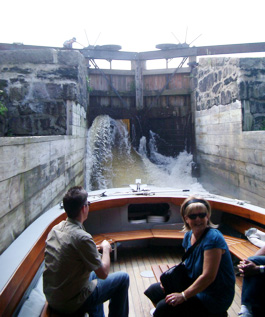 Ascending Swamp Locks |
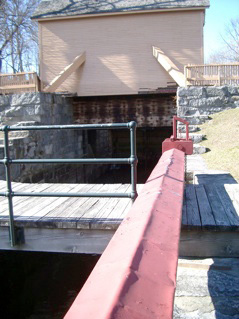 Francis Gate |
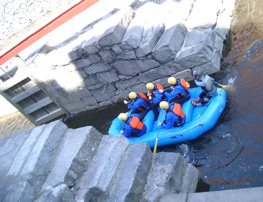 White Water Raft entering lower Warren Locks from the Concord River |
World Canal Conference - Serbia
September 23-25, 2009
by Connie and Tom Raphael
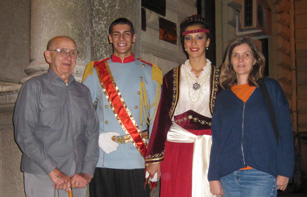 Tom & Connie with Serbian Hosts |
On Saturday evening, September 19, 2009, my daughter Connie and I boarded a Lufthansa flight to Belgrade, Serbia for the World Canals Conference (WCC 09). We landed in Belgrade at noon on Sunday and were met and bused 60 km east to the City of Pozarec in time for an evening reception in the City Hall, the Palace and former capitol of Serbia. We were greeted by the mayor's assistant and a group in historic dress who put on a show of ballroom dancing representing the King, Queen and the court.
The next morning, Monday, we started our two-day pre-conference tours. We were bused along the Danube River to a waterfront resort where we boarded a boat for a six hour cruise to the Kazan Gorge or the "Iron Gate". This is the narrowest part of the Danube River at the ancient cut through the mountains separating the middle Danube from the lower Danube. Here the river is 300 meters deep, has a dangerous current and whirlpools and has served as the physical and cultural separation between Europe and Asia. Here also have been the many battles which have devastated the Balkans for centuries and have left them underdeveloped.
The scenery is spectacular but the currents were too dangerous for our boat; we landed nearby and were bused along the old Roman roads and towpaths along the water's edge, passing Goluba, an ancient Roman fortress along our way. In all, we traveled 200 km east and arrived in Kladova, the easternmost town in Serbia, in time for a late dinner, entertainment and an overnight stay.
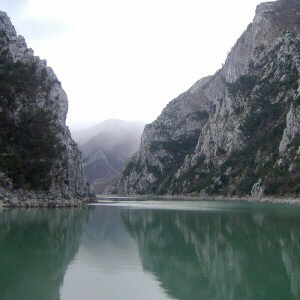 Kazan Gorge, aka The Iron Gate |
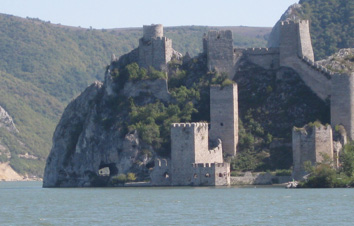 Roman Fortress of Goluba |
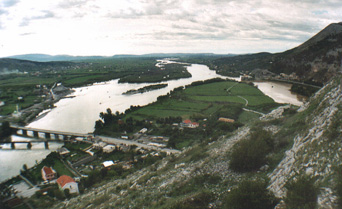 Tisa River |
On Tuesday, we started back West towards Belgrade and Novi Sad for the conference. We visited the massive Derdap 2 hydropower dam and locks just completed as a joint project between Serbia and Romania. It provides the electrical energy and flood control which will be a significant factor in the development of the two countries.
Further along the river we stopped at the archeological site of the Emperor Trajan's first century B.C. seven pier stone bridge across the Danube. We then visited the archaeological site of "Iminatium", one of the largest fortified Roman villages, now being developed as a tourist resort. We saw the excavations of the capitol building and an elaborate three unit bath.
 Novi Sad Lock |
 Kalemegdan Fortress |
Lunch was served Roman style with unglazed serving dishes. After 600 kilometers of driving, the day ended, in Novi Sad, the conference city, in time for a late night reception and dinner.
The conference opened on Wednesday morning with the usual greetings and setting the theme of the conference "East and West will Meet". But, why Serbia? It's an underdeveloped nation on the main river between Europe and Asia, it has been devastated by frequent warfare, and some 70% of the country is mountainous and barely subsists. But the Province of Vojvodina, the remaining 30%, along and north of the Danube, is extremely fertile and productive farmland which could easily feed all of Europe. This is why, starting in 1793 and continuing through the 19th century, a 694 km (418 miles) network of canals was dug to drain the level plains and control the annual flooding. There are 26 sluices, 16 locks, 5 pump stations and a single gate.
Although locks were provided, there has been little commercial or recreational boat traffic and some locks are inoperative. The Province of Vojvodina and the boating industry proponents, "Danube Propeller," are convinced that the future of Serbia depends on developing the boating industry. The European tourist boats and recreational yachtsmen use the Danube to a limited extent. The wonderful ancient castles, fortifications and archaeological sites being developed offer an additional tourist attraction. The scenery is interesting and the people are warm and hospitable. In addition, beyond Serbia, the Danube continues through Romania to the Black Sea, and from there one can proceed back through the Dardanelles to the Mediterranean.
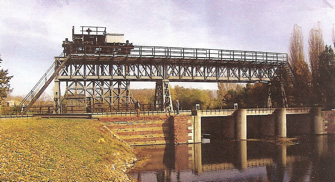 Becej Lock, by Eiffel, 1898 |
The afternoon tour was 60 kilometers to Belgrade. The city has been partly or mostly destroyed 60 times in recorded history and seven bridges were bombed during the last conflict. We saw two bridges recently rebuilt with American funding. We had a quick tour through the rebuilt city, then a visit to the magnificent Kalemegdan Fortress. We toured the Belgrade waterfront by boat and, before returning to Novi Sad, had a reception and dinner at a waterfront restaurant.
On Thursday, the conference discussions focused on the means for developing the boating industries. Serbia has a reasonable riverboat tourist business now and a number of attractive waterfront resort developments, but the infrastructure needs considerable updating and expansion. To provide for dockage, boat service, personal service and resorts significant investment is needed from outside of Serbia. The end result would not only provide an economic base for the whole country but would also provide the Serbians themselves many opportunities for all types of water sports and property development.
In the afternoon we headed north and west to visit the Bezdan Lock, the Becej Lock and the beautifully restored mill, lock and lock keeper's house at Mali Stapar. Here was the technical and business directorate for the Budapest Central Canal Management from 1872 to 1912. The current restored mill was built in 1848 and operated until 1976. The whole town turned out in historic dress. The schools closed so the children could show us the old customs, song, and dance. A very nice meal was served.
Friday's conference was devoted to the problems of international travel, by people and boats, involving monetary exchange, credit, identification, security, navigation, traffic control, pollution and fishing, with terrorism always an underlying concern. These problems extend beyond Serbia and include all of Europe and Asia, as evidenced by WCC 2011, scheduled for the Netherlands, and WCC 2012, in China. An international panel will be sponsored by the Inland Waterways International (IWI) to address these issues.
Connie and I continued our adventure with a week tour of Albania, my parent's homeland. Tom
MISCELLANY
Masthead - Excerpt from a watercolor painted by Jabez Ward Barton, ca. 1825, entitled View from William Rogers House. Shown, looking west, may be the packet boat George Washington being towed across the Concord River from the Floating Towpath at North Billerica.
Back Page - Excerpt from an August 1818, drawing of the Steam Towboat Merrimack crossing the original Medford Aqueduct (artist unknown).
Web Site - As you may have noted from the masthead, the URL for the Middlesex Canal Association's web site is http://www.middlesexcanal.org. Our webmaster, Robert Winters, keeps the site up to date, thus events and sometimes articles and other information will often appear there before we can get it to you through Towpath Topics. Please do check the site from time to time for new entries.
Museum & Reardon Room Rental - The facility is available at very reasonable rates for private affairs, and for non-profit organizations' meetings. The conference room holds up to 60 people and includes access to a kitchen and rest rooms. For details and additional information please contact the museum at 978-670-2740.
